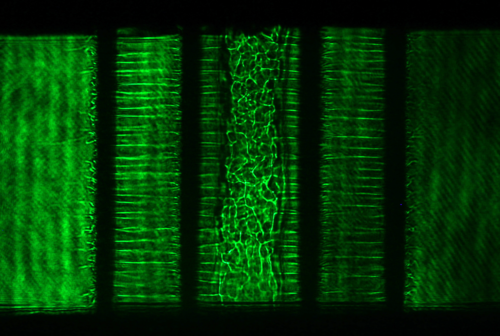Shocks are very important in physics and engineering. They occur whenever there are large pressures involved. In plasmas, we often have very large pressures, caused by magnetic fields or lasers. These pressures can be used to heat and compress matter to conditions not normally found on Earth. For example, we can recreate the conditions in the centre of a planet, or during a meteor impact. Or we can heat and compress matter to the conditions necessary for nuclear fusion.

An image of shock waves forming around a supersonic projectile. Licensed under Public domain via Wikimedia Commons
Shocks aren’t a common occurrence in every day life. In a fluid, like the air or water, energy usually moves around in the form of sound waves. If the pressure increases locally, say by heating it a little or by speaking, a wave is set up that redistributes the excess pressure into the surroundings. When the pressure is too high, however, sound waves can no longer carry enough energy away, and a shock wave is occurs. A shock is a discontinuity (sudden sharp change) in the density and pressure of the fluid.
The actual mechanism for this is difficult to understand using fluid dynamics. This is because the shock front is very narrow, much smaller than the mean free path. The mean free path is the average distance a particle travels before hitting another particle. Fluid dynamics works by zooming out and assuming that particle collide frequently enough that we don’t need to worry about individual particles. This is impossible on small scales, and worrying about individual particles is quite hard – there are billions and billions of them. This makes the physics of what happens inside the shock quite hard.
However, all is not lost. We can use the equations of fluid dynamics to work out the jump in the density and pressure because we know that mass, momentum and energy must be conserved – the amount of fluid flowing into the shock front must equal the amount flowing out, and the energy of the fluid flowing in must equal the energy in the fluid flowing out. This is a neat trick to avoid having to do hard physics, and it works very well indeed.
Shocks always compress and heat fluid – the density and pressure always goes up. Just by conserving mass, momentum and energy, it seems like it should be possible to have a shock wave that lowers the density and pressure. The reason this doesn’t occur is due to thermodynamics. Effectively, we can convert the ordered kinetic energy of a flowing fluid into thermal energy using a shock front, but we can’t convert random thermal energy into a ordered flow.

Three stages of plasma formation. This image looks down onto eight wires (grey cylinders). A current passes upwards through them, out of the screen. In the first stage, the current heats the wires, causing the surface to melt, boil and ionise into a plasma. The current also generates a huge magnetic field (100T) that whips the plasma inwards at supersonic velocities. These ‘ablation flows’ collide in the centre, and a shock front forms. The column of shock heated plasma slowly expands outwards, constantly fed by new material from the ablation flows colliding with the shock front.
We use shocks in MAGPIE to heat and compress plasma. First, we accelerate the plasma to supersonic speeds using a strong magnetic field. Then, we collide the plasma with other plasma flows coming in from different directions. Because the flows are supersonic, sound waves aren’t fast enough to carry away the energy. A shock forms, heating and compressing the plasma. The shock wave begins to expand outwards as more plasma arrives and has its kinetic energy converted to thermal energy. The shock is very efficient at heating – the thermal energy of the material is close to what you’d expect from the kinetic energy of the flows, heating the plasma to around 10 million ‘C. The density is at least four times larger than in the flows, a few times denser than air.

My often used image looking at the side of the wires (contrast with the diagram above looking from the top). The ablation streams are the wavy horizontal lines on the left and right, and the shock wave is the darker vertical line near the centre. The shocked plasma is the rippling column in the centre of the image.
Shocks are very useful for getting to the densities and temperatures we need to understand how to do nuclear fusion. They are quite destructive, however, and they can shred the plasma before it gets to the necessary conditions for fusion. It’s better to add the energy slowly, and let sound waves distribute it evenly within the plasma. This takes a lot more energy, however, as slow heating allows some of the energy to escape. At MAGPIE, we don’t have a lot of energy to play with, so we can cheat and use shock waves to get us to the densities and temperatures of a larger, more expensive machine, and still gain some insight into the relevant physics at these conditions.